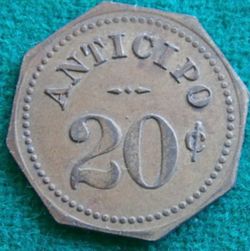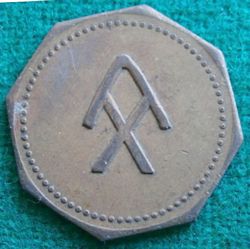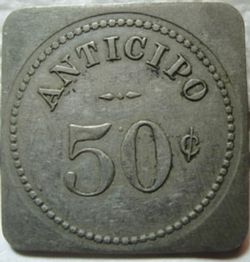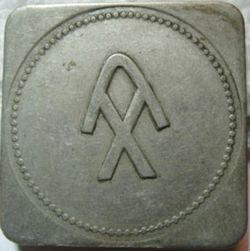Hacienda tokens from Michoacán (later)
Ixtlán de los Hervores
Hacienda de San Simón
Only a part of the structure of what was the Hacienda de San Simón is preserved (the main house, the house of the administrator and the tower of the sugar mill). This hacienda gave birth to the town of the same name located a little more than 20 kilometres north-east of the city of Zamora, Michoacán, in the municipality of Ixtlán de los Hervores, Tanhuato district.
The origin of the hacienda dates back at least to the 18th century. In 1817 the Royalists placed a fortification there against the Insurgents. The Zamoran writer Francisco Garcia Urbizu, affirms that it belonged to the rich landholder José Francisco Velarde de la Mora, owner, among many properties, of the Hacienda Buenavista in Michoacán(?) and of the Casa de la Morena in La Barca, Jalisco, but does not cite his source. General Francisco Velarde was shot on 14 June 1864 in the city of Zamora, because he had declared himself a monarchist during the brief empire of Maximilian. In 1851, the Hacienda San Simón belonged to Nicolás Dávalos y Tompes. He died in that year and left it in inheritance to his·three sons Arcadio, Francisco and Nicolás Dávalos y Jasso.
These brothers maintained control of the hacienda until 1893 when Arcadio died. The large property that included, in addition to the Hacienda San Simon, El Limon and La Plaza began to break up. The house, along with the aguardiente factory and the fields adjacent to the house went to Nicolás Dávalos y Jasso. On his death the following year, 1897, another division left the house and various fields to the Dávalos Garcia and the Dávalos Márquez de la Mora families, the two families that Nicolas Davalos formed. The hacienda, located on fertile lands with both irrigation and seasonal rains, was dedicated not only to agriculture and cattle but also the cultivation of sugar cane from the time of Nicolás Davalos y Tompes who built the sugar and aguardiente factories.
In 1905 a new deed was prepared showing María de Jesús Márquez de la Mora and her children as owners of the hacienda. They sold it in 1909 to the agriculturalist Tomás Sánchez for 100,000 pesos. The land area was 9,987 hectares.
In 1914, the hacienda was confiscated by the Revolution, since all landowners were considered as enemies. An inventory was made by which we know that it had 107 permanent employees, whose weekly salaries were 50 pesos for the administrator and 10 for the secretary, while the salary for the rest of the employees were from 7 pesos for the granary keeper to one peso and 5 centavos for the gate keeper. The common labourer was paid 50 centavos per day because they could not be certain to work seven days per week. From this comes the 50 centavos tokens as the most common, exclusively for the labourer. An informant of Miguel J. Hernández Madrid told him that the lines on payday reached to the entrance of the hacienda of La Estanzuela, half a kilometre distance from the central patio and “payday did not finish until sunset”.
From 1909 till 1949 the brothers Benjamín, Esteban and José María Sánchez, sons of Tomás Sánchez, worked it as part of the “Sociedad Sánchez”. This was dissolved in 1949 upon the death of José María Sánchez and it passed to the control of their sons. The small part of the hacienda that was left by the Reforma Agraria (in 1948 only 3 78 hectares were protected by a court writ) was administered by Roberto and Felipe Sánchez Villasenor who had no experience in agriculture and upon the death of Felipe in 1975, the six survivors decided to dissolve the society and sell it.
María Elena Sánchez Villaseñor, daughter of the last owner, saved a group of 470 tokens. This included ten different denominations, eight of metal and two of cardboard, as follows:
Obverse: ANTICIPO / 10¢
Reverse:
20.5mm. tin, octagonal
Obverse: ANTICIPO / 15¢
Reverse:
22mm. tin, octagonal


Obverse: ANTICIPO / 20¢
Reverse: brand
24.5mm. tin, octagonal
Obverse: ANTICIPO / 25¢
Reverse:
28.5mm. tin, octagonal
Obverse: ANTICIPO / 10¢
Reverse:
20.5mm. tin, octagonal
Obverse: 25 L/S maiz
Reverse:
24.5mm. tin, circular


Obverse: ANTICIPO / 50¢
Reverse: brand
28 x 28mm. cupronickel
Obverse: $1 maiz
Reverse:
31 x 31mm. cupronickel
For the cardboard cartones see Haciendas (northern Michoacán).
We do not know the year in which the metallic tokens were made but it must have been after August 1909 when Tomás Sánchez purchased the hacienda (the cardboard tokens date from the Revolution). They were used until 1920 according to the information of Antonia CoronadoInterviewed by Teresa Lara Campos during May 2003. During 1917 the circulation of these was prohibited and in 1924 it was prohibited to use them for payment of salaries.
(based on Ignacio de Jesús Sáchez Montes, Hacienda Tokens of San Simón, Michoacán)
